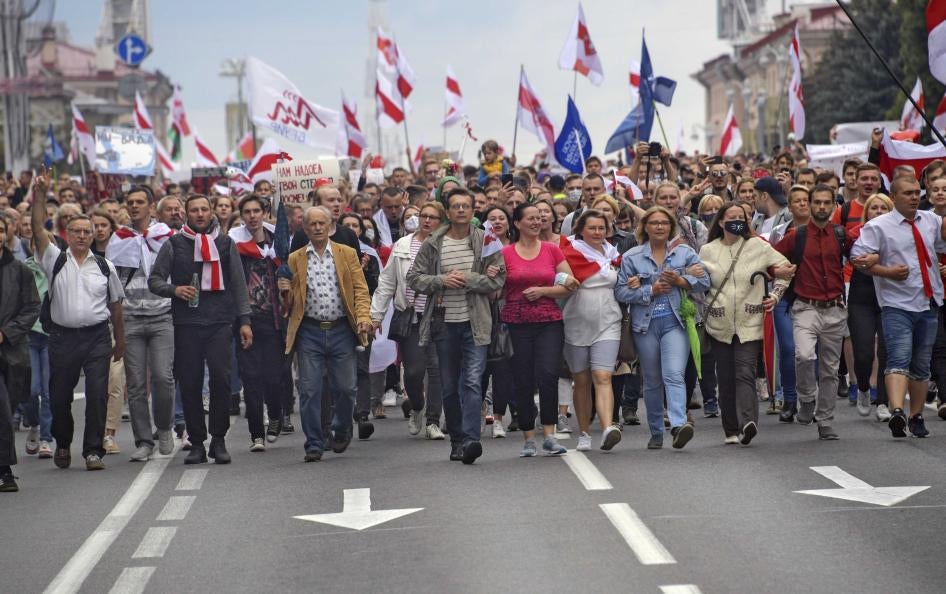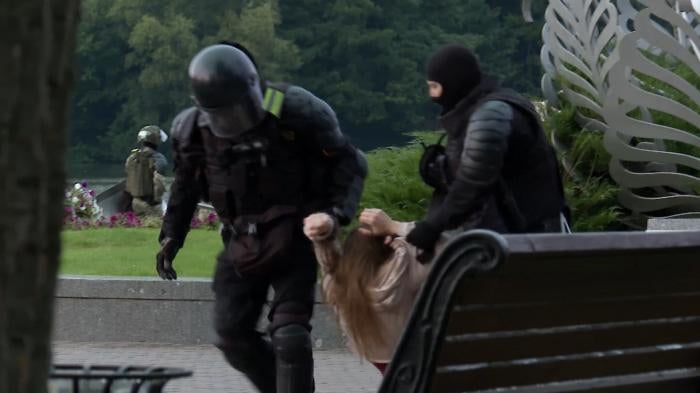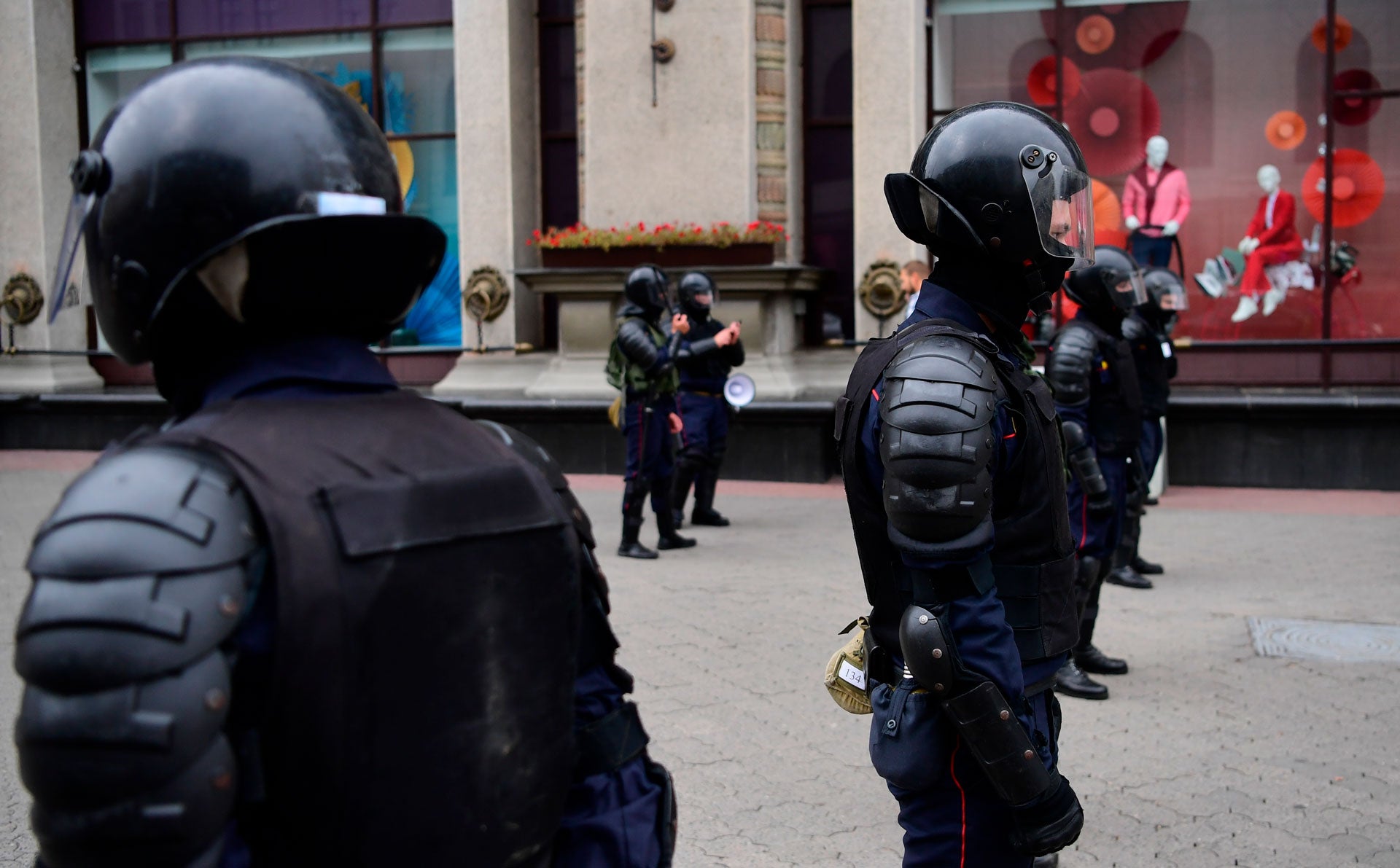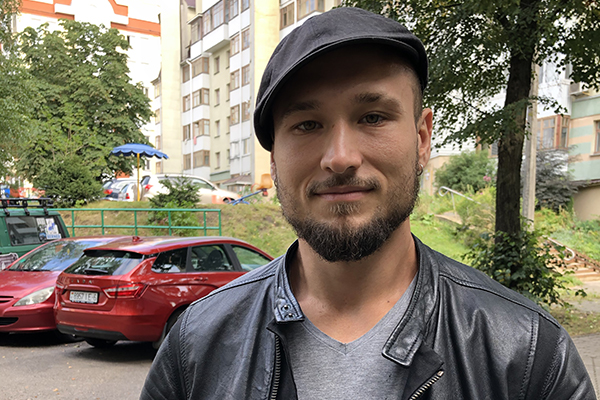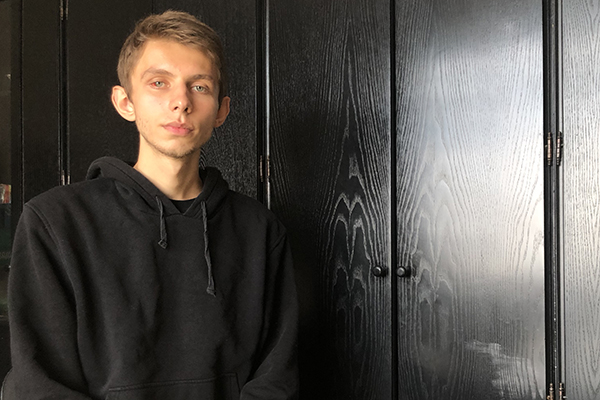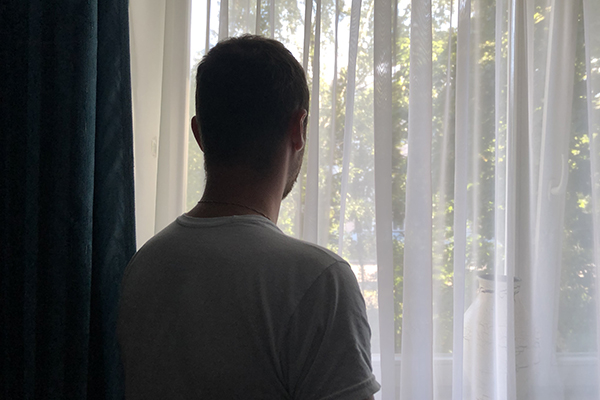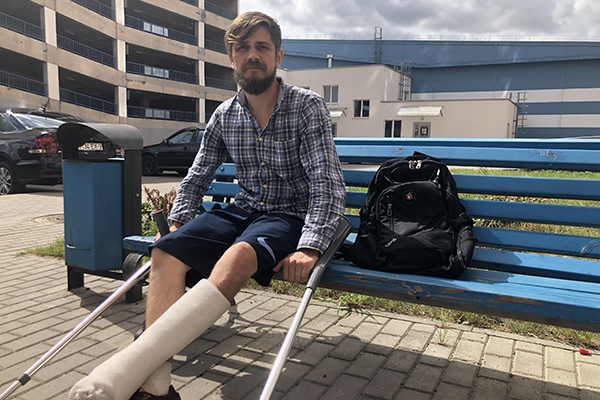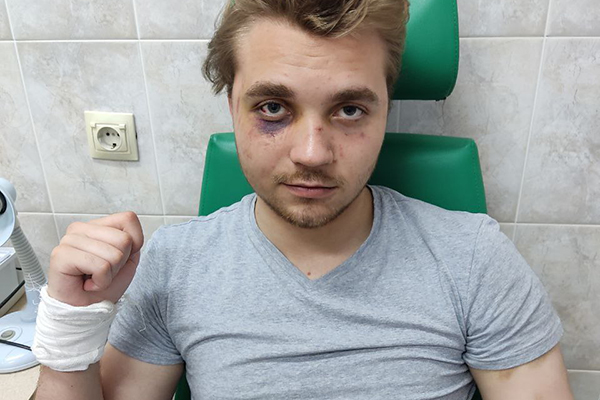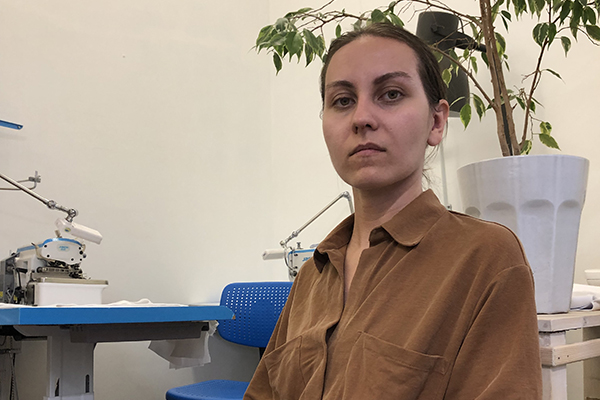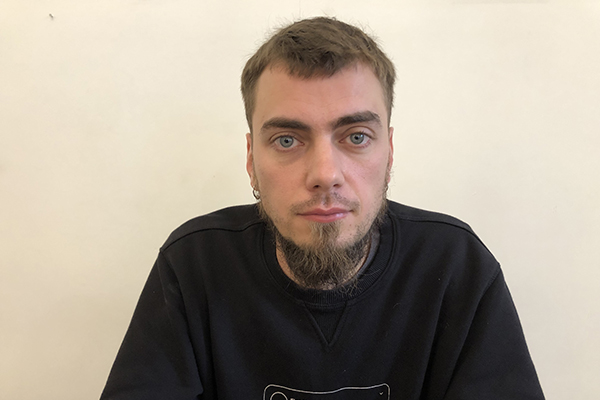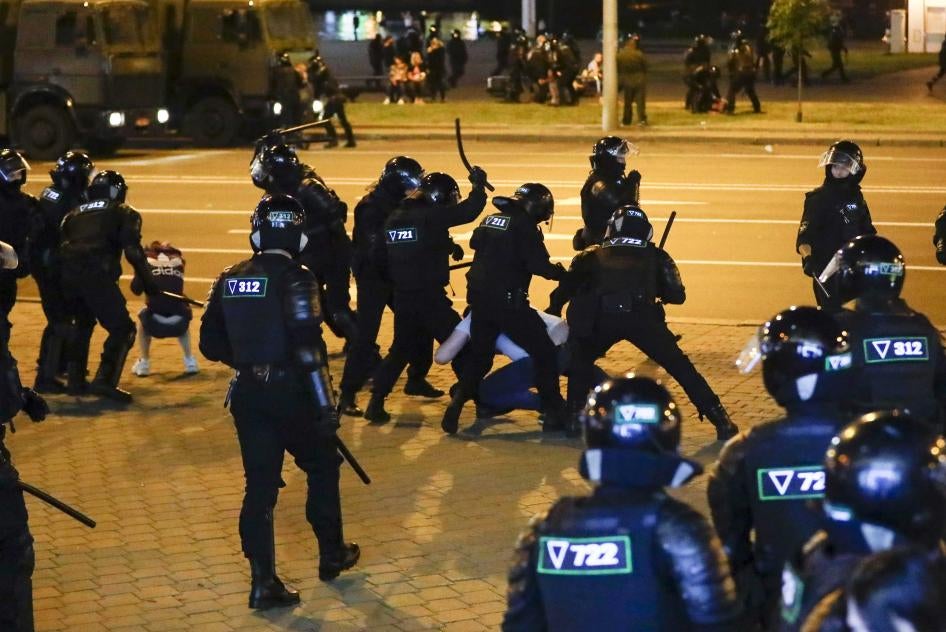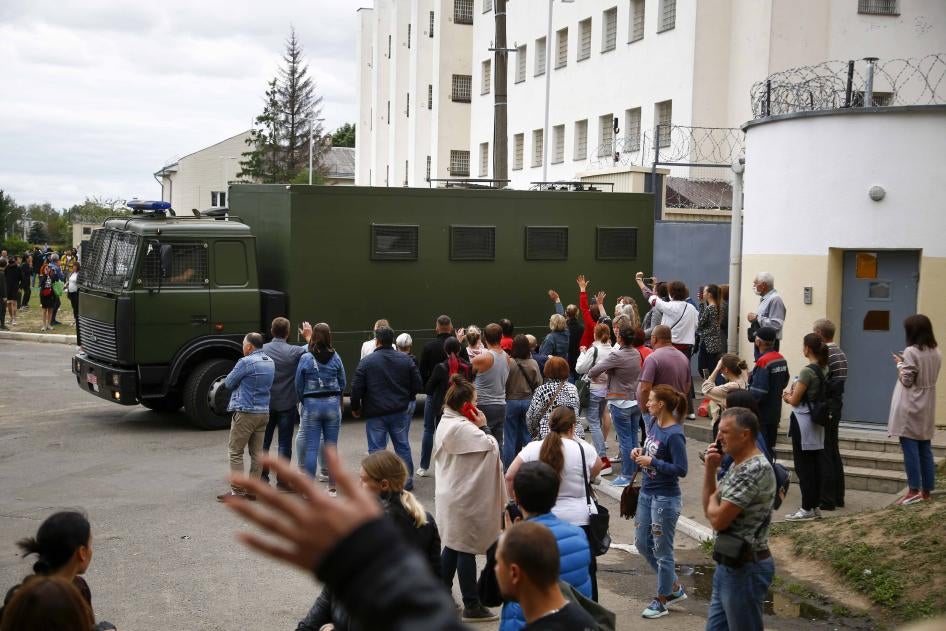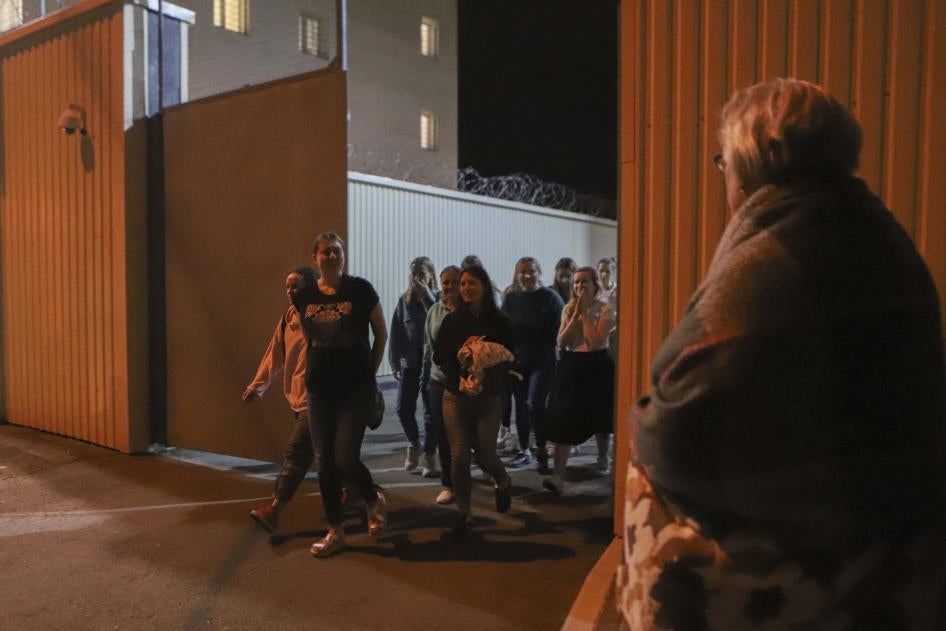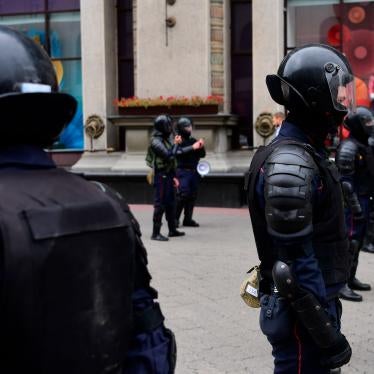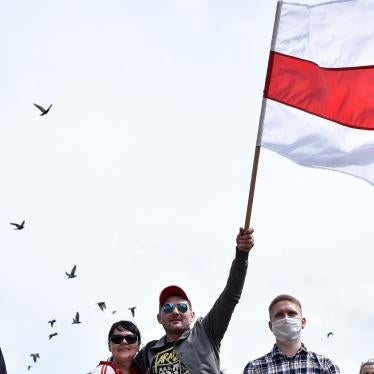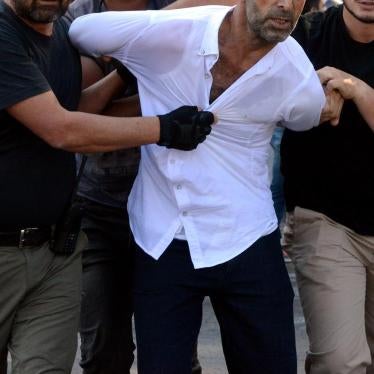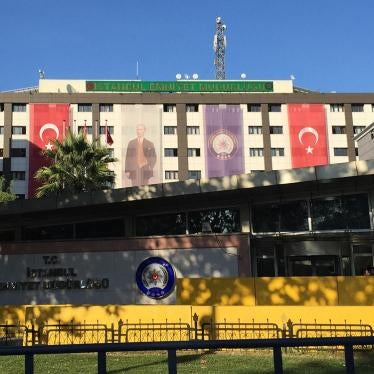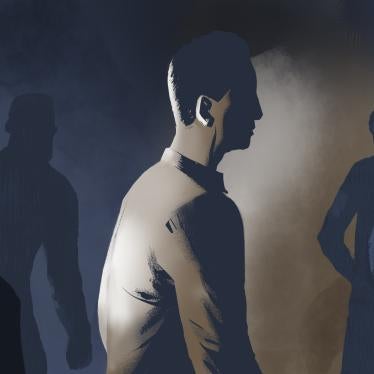(Berlin) – Belarusian security forces arbitrarily detained thousands of people and systematically subjected hundreds to torture and other ill- treatment in the days following the August 9, 2020 presidential election, Human Rights Watch said today.
The victims described beatings, prolonged stress positions, electric shocks, and in at least one case, rape, and said they saw other detainees suffer the same or worse abuse. They had serious injuries, including broken bones, cracked teeth, skin wounds, electrical burns, and mild traumatic brain injuries. Some had kidney damage. Six of the people interviewed were hospitalized, for one to five days. Police held detainees in custody for several days, often incommunicado, in overcrowded and unhygienic conditions.
“The sweeping brutality of the crackdown shows the lengths to which the Belarusian authorities will go to silence people, but tens of thousands of peaceful protesters continue to demand fair elections and justice for abuses,” said Hugh Williamson, Europe and Central Asia director at Human Rights Watch. “The United Nations and the Organization for Security and Co-operation in Europe (OSCE) should urgently set in motion inquiries to ensure that evidence is collected that could contribute to accountability for grave human rights violations.”
The UN Human Rights Council, which will hold an urgent debate on Belarus during the session that will run from September 14 to October 6, and the OSCE should promptly open inquiries.
Human Rights Watch interviewed 27 former detainees, 21 men and 6 women, nearly all of whom said they were arrested between August 8 and 12. Some were arrested as they took part in demonstrations that they described as peaceful; others were grabbed off the streets or from their cars. Many shared medical documents and photographs of injuries. At least five still had bruises and/or wore casts at the time of the interview. Human Rights Watch also spoke with 14 people with knowledge of the arrests and abuse, most between August 20 and 29, in Minsk, Hrodna, and Homiel, including witnesses to arrests, healthcare workers, and detainees’ relatives. Human Rights Watch also examined 67 video recordings and written accounts by former detainees and their relatives, either from public sources or shared directly with researchers.
On the basis of Human Rights Watch’s findings, much of the physical abuse by riot police and other law enforcement agents constitutes torture, as do the detention conditions that interviewees described.
From August 9 to 13, police arrested nearly 7,000 people amid an unprecedented wave of popular and largely peaceful protests. They alleged widespread election irregularities that led to the contested re-election of the incumbent, Aleksander Lukashenka, who has been in power since 1994.
With protests in their sixth week, Belarusian authorities have expelled, harassed, or stripped of accreditation dozens of foreign journalists and local journalists working for foreign and local independent outlets. Starting the first week of September, they have begun to again arrest protesters in large numbers, with the Interior Ministry reporting more than 600 detained on September 6 alone, and more than 300 in custody.
Detainees said that police, riot police (known as OMON, or Special Task Police Force), and special designation forces (Spetznaz) picked them up off the streets, in some cases using extreme violence, then beat them in dangerously confined spaces in vehicles where they had trouble breathing.
The security forces transported the detainees to police precincts and other detention facilities where they kicked, punched, and beat them with truncheons, forced them to stand, kneel, or lie in stress positions for hours, then held them for days in overcrowded cells. Police often denied detainees food and water and denied their requests to go to the toilet. All said they saw dozens of others subjected to similar or worse treatment.
In Hrodna, a 29-year-old journalist said that when he was arrested, despite displaying his press credentials, an OMON officer broke both his wrists. A medic described witnessing an incident in Minsk on August 11, in which an OMON officer trying to arrest a motorist who had stopped his car shot a rubber bullet point-blank at him. The medic said she treated the victim on the side of the road, but he ended up needing surgery to extract the bullet from his lungs.
The aim of the abuse, former detainees said, appeared to be to punish and humiliate. Most reported that OMON and other security forces singled out detainees with so-called “atypical” looks, such as men with long or dyed hair, and people with dreadlocks, piercings, or tattoos, for worse treatment and more insults.
Detainees said that police and guards confiscated detainees’ medications, frequently ignored calls for medical care, and in some cases denied it altogether. In one case, a detainee with a pre-existing medical condition was ill-treated and denied timely medical attention. He fell into a coma in custody and was clinically dead by the time he was transferred to a hospital. Three healthcare workers said they treated numerous demonstrators and former detainees injured by police. Some of those tortured asked the health workers not to file the violent injury reports that are required by law, for fear of retaliation.
All of those interviewed said they were denied access to a lawyer. Those taken before a judge said the proceedings lasted only a few minutes and ended with short arrest sentences for administrative offenses. Some of them said they were released early, most likely because of overcrowded detention facilities.
Those who had no court hearing said they were released within 72 hours, the maximum period allowed under Belarusian law before a court hearing is required. All said that when released, they had to sign a document promising not to participate in “unsanctioned assemblies,” and were given a written warning of criminal charges if they did.
Police and detention center officials failed to keep track of the thousands of people arrested, and detainees’ family members said they struggled, in many cases for days, to find out where their relatives were or what happened to them.
Dozens of former detainees lodged complaints with the authorities alleging cruel and degrading treatment by police. Human Rights Watch is aware of several preliminary inquiries launched by the authorities, but they have not yet opened a single criminal case at time of writing.
Belarusian human rights groups have filed a submission in the interests of 47 former detainees with the UN Committee Against Torture alleging cruel and degrading treatment by police.
On August 14, the deputy internal affairs minister denied that anyone had been beaten or tortured. On August 26, the prosecutor’s office announced the creation of an inter-agency commission to “objectively and fully” gather facts about any criminal acts by law enforcement, both during arrests and in detention facilities.
The torture and other ill-treatment Human Rights Watch documented violate many of Belarus’ international human rights obligations and commitments, including as a party to the International Covenant on Civil and Political Rights (ICCPR) and the UN Convention Against Torture, as well as a participating OSCE state.
The UN Human Rights Council decided on Monday that it will hold an urgent debate on Belarus. The council should pass a resolution asking the Office of the UN High Commissioner for Human Rights to monitor and publicly report on violations before, during, and after the elections, and to determine the facts and circumstances of such violations, with a view to pursuing accountability.
The resolution should also condemn the human rights violations in Belarus, including the disproportionate use of force against peaceful protesters, arbitrary arrests, ill-treatment, and torture. The council should call for the immediate release of those who remain in arbitrary detention, including journalists, protesters, opposition leaders, and their supporters.
OSCE countries should also trigger the so-called Moscow Mechanism for an investigation by an independent expert to establish the facts and present the results and recommendations to the OSCE.
“Torture survivors are courageously pressing for justice, and the UN and OSCE should play their part in ensuring justice for victims and accountability for those responsible for human rights violations in Belarus,” Williamson said.
For detailed accounts, please see below.
Abuse Immediately Following Arrest
All former detainees interviewed described their arrest and transfer to police stations as fraught with abuse. Several people said that they experienced the worst abuses in police vans and other vehicles. In 10 cases, the security forces used violence when arresting the protesters. Thirteen said that OMON officers forced them and up to three other people into the vehicles’ small, locked compartments, designed for one to two people. Detainees held in such compartments, sometimes for hours, recalled difficulty breathing. In seven cases, OMON forced detainees to lie on top of each other on the floor of the vehicles, beat them, and humiliated them.
Seven male and two female detainees said OMON officers threatened them with rape, in most cases while they were in transit. Human Rights Watch documented four cases in which police cut male detainees’ clothing in the buttocks’ area to reinforce the threat. One of these men said a police officer subsequently raped him.
Security forces kicked, punched, and used truncheons to strike men in police vehicles. Women said they were threatened, humiliated, pushed and shoved, and beaten, albeit less severely than men, and otherwise ill-treated. Some of those interviewed asked not to have their real full name used.
Ales, a 30-year-old IT worker, said he was raped by a senior OMON officer with a truncheon after his arrest at a protest in a police van on August 11 in central Minsk:
[Riot police] demanded that I unlock my phone. I refused. They called a senior officer. He threatened that unless I cooperate, he’d stick his truncheon up my [ass]. He then cut my shorts and my underwear on the back, crosswise, and called out to his officers asking whether anyone had a condom. I was on the floor, face down, but I could see him pull the condom on the truncheon – and then he just pushed the stick into my anus…. Then, he pulled it out and demanded the password again. He kicked and punched me on my ribs, on my face, on my teeth – my two front teeth cracked a bit.
Medical documents he shared with Human Rights Watch confirm hematomas to his scrotum, perianal area, and left eye, and a concussion. Human Rights Watch examined photographs of his injuries and observed during the interview, 17 days after his detention, a large fading hematoma under his eye, and damage to his teeth.
Alexander Brukhanchik, 18, a college student from Minsk, said that police detained him and two friends, also students, on August 11 as they walked at night in a residential area, and handed them over to a group of OMON officers. He said the officers took the three inside a minibus, kicked them repeatedly, cut their shorts in the buttocks area and threatened to rape them with a grenade. One officer cut off Brukhanchik’s shoulder-length hair.
The officers transferred the three to a police van, forced them to crawl on the blood-splattered floor, and beat them. “I particularly remember being kicked with a booted foot close to [both eyes] and on my nose,” he said. “These blows caused the most pain, and my nose squirted blood.”
Human Rights Watch reviewed medical documents with Brukhanchik’s diagnosis of multiple hematomas and a nose fracture.
Alexander Gazimov, 35, a construction worker, said he was detained in the aftermath of a protest on August 10 in northern Minsk. Gazimov initially tried to evade arrest but broke his leg in the effort. When the officers caught him, they threw him into a van and showered him with blows for about 10 minutes “all over” his body and head, he said. The police repeatedly stepped on and kicked his broken leg, inquiring with fake concern, “Is this leg really broken?” Gazimov said the officers also threatened him with rape.
Sergiy Melyanets, 40, a sales manager and an active member of a Baptist congregation, said that riot police pulled him out of his car in central Minsk on August 10 and forced him into a van, where they beat him and prodded him with an electroshock weapon:
They opened the [van’s] side door and I saw people lying between the seats, face down. The officers told me to crawl over them.... I was slow and they started to beat me.... One officer was yelling, ‘Who’s the organizer? What were you doing [at] this demonstration?’… [when] I was saying I was only there to pray for Belarus, he would hit me with an electric shocker on my arms, legs, and back.
Human Rights Watch reviewed Melyanets’ medical reports, which note “electricity trauma – the result of electric shock impact.”
Riot police detained Pavel, 22, as he walked toward the center of Hrodna with a friend on August 10, and forced them into a minivan. Pavel said that two officers hit him in the ribs three times. When his friend asked why they were detained, the officers hit him too. During the drive to the station, the officers “ordered us to raise or lower [our] hands and beat us if we didn’t,” Pavel said.
Andrei Torgonsky, 32, a repairman, was detained on August 9 while walking toward a monument in central Minsk to see whether a demonstration was taking place. He said that riot police pushed him and two other men into a small cell inside a stifling van:
After 30 minutes, we were completely drenched in sweat. It was hard to breathe. [The van] started moving immediately but stopped two more times to take in more people. Then one man in another cell started fainting, so they pulled him out of the cell and put him on the floor.
Ekaterina Novikova, 34, was detained in central Minsk as she attempted to cross the street:
Riot police were blocking the road and wouldn’t let me through, so I asked for their superior, [who] grabbed me by the neck and dragged me into this regular-looking yellow bus. Inside, he hit me on the head, calling me names, pulled my hair, and then shoved me to the floor.
She said that police brought three other women onto the bus, and the superior shouted abuse and threatened her and the other women, saying that they would “rot in jail.” When one of the women started crying uncontrollably, he drenched her with water.
Diana, 24, a web designer, was detained on August 11 with four female friends and one male friend in central Minsk, while putting up opposition posters at a bus stop. She said that riot police forced her to kneel inside a minibus, hands tied behind her back with zip-ties and head against the back of the person in front. She said her hands were bound so tightly her wrists bled. The officers shouted, “We’ll make sure you get 10 to 15 years in prison. You’ll be gang-raped there, and you’ll come out old and decrepit with useless vaginas.” She said that officers hit her and the young man with truncheons, once on the head and once on the hands.
Beatings, Torture, and Cruel, Inhuman, and Degrading Treatment in Detention Facilities
Once arrested, detainees were mostly first taken to police precincts, also known as RUVD (the local acronym for district department of internal affairs), to be registered, and then onward to short or long-term facilities, such as the Okrestina Detention Facility in Minsk or Zhodino Prison located about 50 kilometres away from Minsk.
Human Rights Watch documented beatings at seven police precincts in Minsk, one in Homiel and one in Hrodna, as well as at the Okrestina Facility at the Hrodna Prison. Detainees said that when they arrived, OMON officers continued to beat them, sometimes forcing them to walk through two lines of officers with batons, hitting or kicking and punching them on the head, back, chest, and abdomen. All the male detainees and some of the female detainees said that before detainees were transferred to cells, they were forced to kneel or stand, with their tied hands behind their heads, or lie on the ground, hands tied tightly behind their backs, for several hours, and were beaten if they complained or shifted position.
Detainees were held in severely overcrowded cells. A 28-year-old man held at the Moskovsky RUVD, for example, said he was held in a 3-by-5 meters cell with about 30 other men and no toilet.
Two men said police shocked them with an electroshock weapon and saw other detainees stunned with similar weapons. Four had bone fractures due to police abuse.
Minsk Police Precincts
After his arrest, police took Brukhanchik and his two friends to Frunzensky RUVD. There, Brukhanchik said, police beat all three brutally, gave them electric shocks, and threatened to rape them with a truncheon. At one point, an officer yelled, “We won’t leave a single intact spot on your body, you’ll be lying here in your own shit and pee.”
Melyanets said that OMON took him to Leninsky RUVD, driving him into a yard containing several garage-like structures, surrounded by a wall topped with barbed wire. He said:
They shouted, ‘Out, out!’ and a corridor of OMON officers [surrounded and] beat us all the way into the garages. Then we had to stand against the wall for hours, with our forehead pressed against the wall, our legs spread, and our hands behind our backs.
Diana was taken to Moskovsky RUVD on August 11. She said that with each new group of detainees police brought into the main hall, the beatings increased in violence. “They forced people to crawl on the floor, and only after the beatings did they ask questions,” she said. “We tried to cover our ears because of the screams.”
On August 10, OMON arrested Kim Mazur, a 31-year-old financial technology specialist, with a friend while they were parked next to a Minsk shopping center where a protest had taken place the day before. The officers took the two to Partizansky RUVD. There they forced Mazur to kneel, hands behind his back and his head to the ground, overnight.
Around midnight, he said, officers rushed into the room and started beating everyone, while a commander instructed the guards not to let anyone sleep. The next day, as detainees were waiting for their transfer to Zhodino Prison, Mazur said, an officer instructed police to “beat him as much as possible and break his legs.” He said they punched him in the jaw and kicked him in the back and legs.
Konstatin Reutsky, a Ukrainian journalist arrested while filming OMON detaining people on Independence Avenue on August 12, was taken to Sovetsky RUVD. There, he said, he and dozens of others were kept in stress positions for 17 hours. Reutsky said OMON officers repeatedly punched and hit them with batons whenever they would move or shift weight and that he saw them hose some detainees with cold water.
After arresting Gazimov, OMON drove him to the Tsentralny RUVD. There, he said, he was forced to stand against the wall, despite his broken leg: “I started to lose consciousness and so they laid me face down against the ground. But they kicked my broken leg four or five times while I was flat on the ground.”
Vitaly Dubikov, a 33-year-old journalist arrested on August 10 while on his way to cover a protest, was taken to Zavodskoy RUVD. Dubikov said about 50 detainees were herded into the courtyard there while OMON officers kicked and hit them with truncheons and ordered them to drop to the ground, face down. Dubikov said that officers then tied detainees’ hands with construction zip-ties and left them on the ground for several hours, beating anyone who complained.
Abuses at Okrestina Street Detention Facility
Once processed at the police stations, detainees said, they were taken either to Zhodino Prison, which they described as overcrowded but less abusive, or to the Okrestina Street Detention Facility.
All male and some female interviewees held at Okrestina said they first had to stand or kneel in stress positions for several hours against the walls of the courtyard.
Olga Pavlova, 32, was arrested during a protest and taken to Okrestina on August 9. She said that an officer there hit her head against the wall several times while yelling, “You don’t have any rights, you bitch! What do you think you are, whore, a straight-A student, smarter than everyone else?” She asked for a doctor and he hit her head against the wall once again.
Alia, 22, arrested on August 9, said she was held in a roofless cell with about 40 women and that they had to use a hole in the floor as a toilet and to share 1 liter of water for 6 to 8 hours.
Kirill Tsiukulman, 27, whom OMON arrested while he tried to join a protest, recalled being held in a similar roofless cell on August 13 for 17 hours, with about 120 other men:
They brought us a two-liter bottle of water... Some of the guys had been tear-gassed and ... were parched. Others were severely injured. One guy had his head split like the Grand Canyon. Some couldn’t walk.
Once processed, detainees said, they were taken to various cells inside the facility. Five women held at Okrestina at varying times from August 9 to 11 said they were taken to cells with 4 beds that held 20 to 50 detainees.
Maria, an independent election observer who was arrested by security forces as she left a protest on the night of August 9, said:
When the door of the cell opened, I thought that this would probably be the end for us. The cell was for 4 people. There were already 23 girls sitting there. There was no air. There was no food. No toilet paper. Some girls started menstruating. And when we asked for sanitary napkins, guards would say, ‘Use your t-shirt.’
From their cell, the women could hear men being subjected to horrendous beatings in neighbouring cells. “One of the men was beaten to such a state that he [was urinating] blood and the [guards] yelled at him to clean up after himself,” Pavlova said. “The man cried … but they continued beating him and shouting.”
Abuses in Hrodna and Homiel
Four men who were held in three different detention facilities in Hrodna and Homiel described riot police using similarly abusive methods against detainees.
In Hrodna, Pavel said, OMON beat him when he arrived at the town’s prison on August 10. “We had to run through two lines of [security forces] trying to make us trip, and we had to dodge their blows,” he said, adding that he was hit three times.
In Homiel, two interviewees were taken to the fourth floor of Tsentralny RUVD, where OMON brutally beat them. Dmitry Lukowski, arrested on the street by police on August 11, described a corridor full of OMON officers waiting to beat him and the other detainees. “At first I kept silent, but then I started screaming,” he said. “I fainted, but they splashed water into my face and continued to beat me. There was blood everywhere and I saw a few teeth on the floor [not his own].” At some point, he said, a policeman grabbed him by the hair and said, “So, Lukowski, you want a lawyer?” When he answered, “Yes,” the officer beat him again and asked, “So, Lukowski, you still want a lawyer?”
Transfer from Police Stations to Okrestina and Zhodino Detention Facilities
Many of those interviewed said that OMON officers abused them when transferring them from police stations to either Okrestina or Zhodino in windowless, overcrowded vehicles with practically no ventilation. In some cases, they said, riot police kept detainees in stress positions for hours and beat them for shifting position or complaining. Those transferred to Zhodino, 50 kilometers from Minsk, had to endure more due to the long drive.
Dan Peleschuk, 34, a freelance journalist and United States national, said his transfer from the Pervomaisky Police Station to Zhodino on August 11 was “the worst part” of his traumatic detention experience:
[Riot police] piled us into what looked like a military truck with benches on the sides, and made us kneel on the metal floor, foreheads under the bench, hands behind the back. The drive probably took [90 minutes], but it felt like an eternity. Soon, I couldn’t feel my legs and was crying out in pain. Those who asked to be allowed to get up were kicked and punched. When we arrived … there must have been other vehicles in front of us. We would move, then stop, then move again, and the whole time the police were saying, ‘You wanted a revolution, now you’ll see what it’s like! Welcome to the worst place on earth.’
Mazur said that during his transfer from Partizansky RUVD to Zhodino, riot police piled him and 19 other detainees on top of each other in a van and beat them. “You had to crawl like a worm on top of the other detainees while they are beating you to go faster, but you have to slow down so you don’t squash someone’s head as you move,” he said. “They also walked on top of us.” One officer put his boot on Mazur’s friend’s neck, nearly choking him. Police also cut off one of the detainee’s dreadlocks, he said.
Alexei told a similar story, regarding his transfer from Leninsky RUVD to Zhodino, during which OMON officers struck him with a truncheon five times and hit the young man next to him for shifting his body position. Alexei also said that officers beat a green-haired detainee and “looked for scissors to cut it off but did not find any.”
Sasha, 28, an engineer, was detained on August 10 during a peaceful demonstration in central Minsk and taken to Moskovsky RUVD. He said that during the transfer to Zhodino, he suffered “the worst beating [I] went through [during detention]”:
Everyone was hit on the way there, and then they started to stack us on top of each other between the benches of the van. They were saying “faster” and hitting us.... I thought [my legs] [would] break from the weight. I thought I’d be crushed.... Then they tried to fit in five more people, so they told us to get on our knees and they tied our hands behind the neck with zip-ties, very tightly.... After a while, I stopped feeling my left leg.... They made us sing the national anthem. Most people know [only] the first lines … so they beat them.
All said the vehicles became stiflingly hot. The heat worsened when the vehicles arrived at the detention facility gates, parked in the sun, sometimes for hours, waiting to be admitted.
Dubikov, who was transferred from Zavodskoy RUVD to Zhodino on August 11, said:
We were crammed in, like fish in a barrel, drowning in our own sweat.... When the van arrived at Zhodino, the queue by the entrance was two to three hours long. There was no air at all.... One guy had either epilepsy or asthma and he started having seizures after about 1.5 hours. Then they relented, gave us some water, let some air in.
Denial or Delay of Medical Care
Under international norms for the protection of detainees, every detainee is entitled to a free and proper medical examination as promptly as possible after their admission to the detention site and appropriate medical care and treatment as required, including transfer to a hospital or medical facility when necessary.
All former detainees said the authorities either denied them medical care or that they witnessed authorities deny other detainees medical care. In some cases, they said officers responded to requests with threats or ill-treatment. With few exceptions, police called ambulances only when a detainee lost consciousness. When police confiscated detainees’ belongings, they took away medications from people with chronic conditions, including diabetes, and did not return the medications unless the detainee’s condition deteriorated dramatically, those interviewed said.
Police at Zavodskoi RUVD ignored repeated requests by Ales, who was in severe pain after being beaten and raped with a truncheon, to see a doctor.
Ales said police called an ambulance for another man who had diabetes and whom Ales saw collapse after authorities denied him insulin but refused to put Ales in the ambulance as well.
“When I was allowed to go to the toilet [several hours later] I saw the [scope of the] bruising and swelling [in the perianal area] and again, asked to see a doctor. They refused again,” Ales said.
Only after Ales was transferred to Okrestina did a doctor finally examine him and called an ambulance that took him to an emergency ward around 2 a.m. on August 13, more than 30 hours after his rape.
Nikolai Novoselsky, 21, said that his arm was broken and became swollen and throbbed with pain. Although he repeatedly flagged it to the police and to guards at Okrestina, he received no medical care. His cellmates pleaded unsuccessfully with the guards to call him an ambulance. Noveselsky spoke of a cellmate at Okrestina, who had diabetes. “He needed his insulin shot and was lying in the corner, all bluish-yellow, and moaned, but no one examined him,” he said.
When Novikova persistently asked wardens at Okrestina for a doctor, an officer threatened her: “If you continue with the yelling, you’ll have this [truncheon] up your …” Novikova also said that one of the many women in her cell was diabetic. “It took an hour to convince the guards to return her insulin, and “[by] the time they finally brought it, she was barely conscious,” she said.
Missed insulin doses or denial of insulin therapy can lead to life-threatening complications for some people with diabetes.
Three women described their experience in their overcrowded cell in Okrestina, where 35 women were crammed into a cell with 4 beds. Maria said that two young women struggled to breathe and began to vomit, but when they made repeated requests for a doctor, the wardens poured a bucket of cold water over all of them.
Olga Pavlova and Yulia Bolievskaya were in the same cell and corroborated the story. Pavlova said that cuts on her arm and leg, sustained when police brutally dispersed a protest she was at on August 9, were festering, but the guards ignored her requests for medical care. Bolievskaya, 28, said that when she was arrested, police confiscated the medication she takes daily for a chronic condition and did not return it until after she was released, ultimately from Zhodino, on August 14.
On August 10, riot police at Zavodskoy Police Station forced Dubikov and many others to lie on the ground outdoors. A man next to Dubikov called out that he had a kidney transplant, that lying on the cold ground was dangerous for him, and that he needed medical care. In response, they kicked and hit him with truncheons.
Dubikov also said that when he and other detainees arrived at Zhodino on August 11, a staff doctor made a quick appearance and “arranged for an ambulance for a man with fractures.” However, he waved away all health complaints by other detainees, some of whom had been severely beaten, saying: “You should’ve stayed home.” Dubikov said that one of the detainees complained of nausea and dizziness and believed he had a concussion, but the doctor did not examine him.
Peleschuk said that when he arrived at Zhodino, a doctor asked whether anyone had any complaints. Given the police presence and abuse everyone had endured, not a single detainee dared complain. The doctor did not examine anyone, though several had visible bruises.
